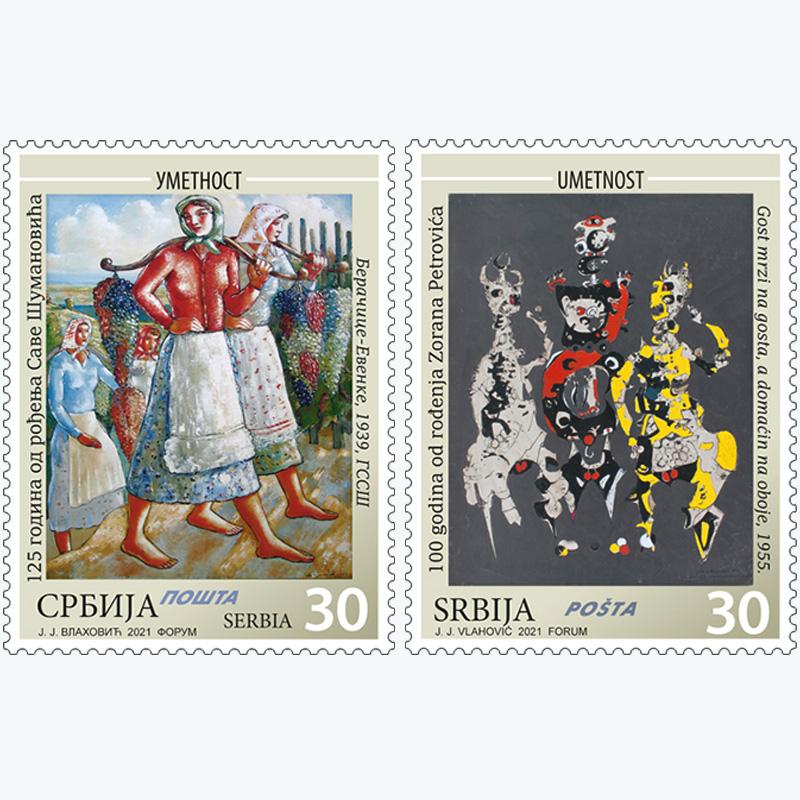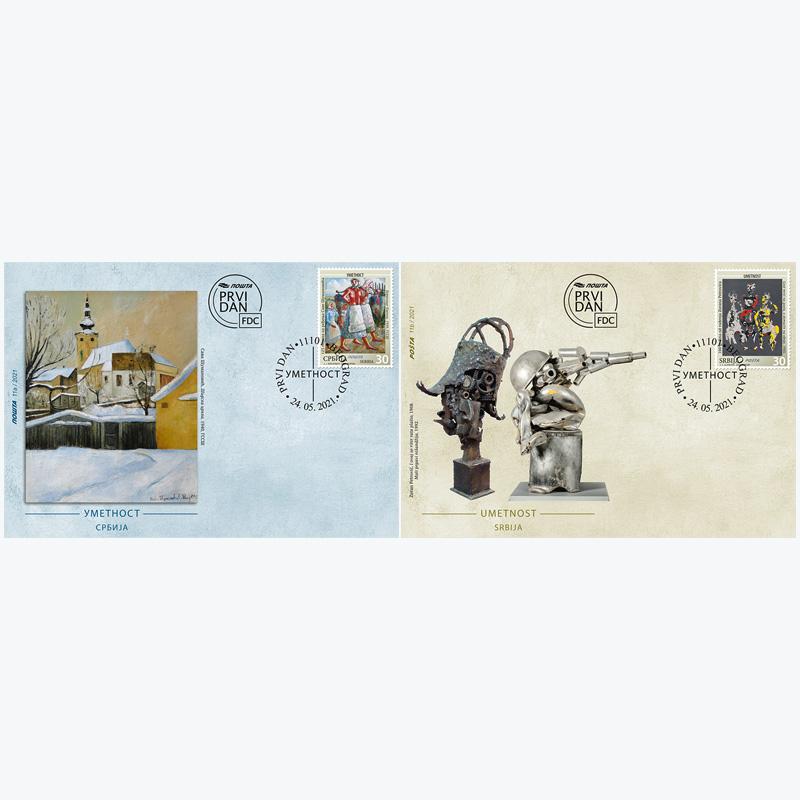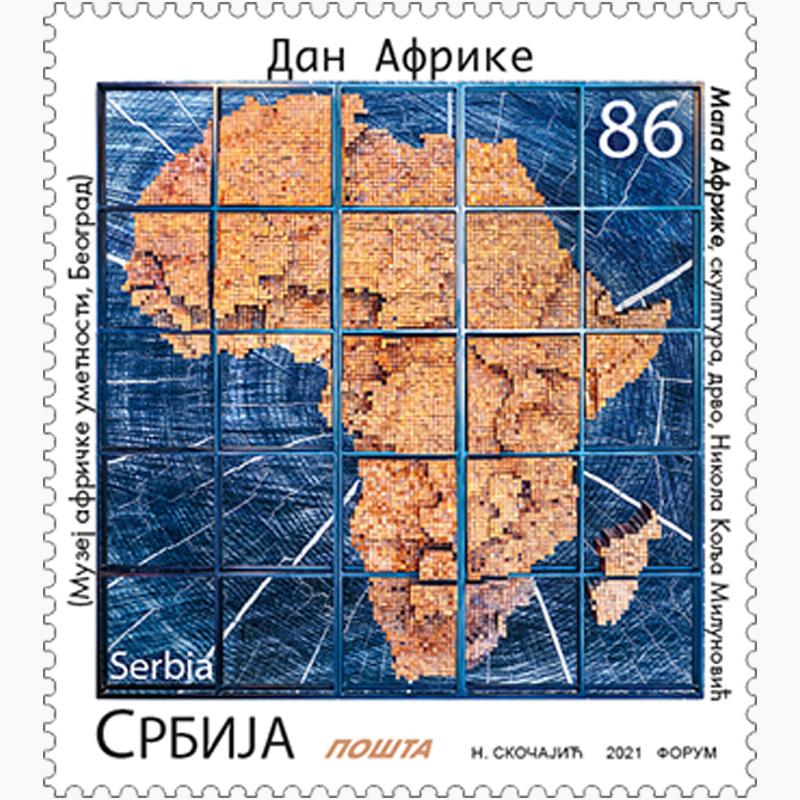Description
125 Years since the Birth of Sava Šumanović
Sava Šumanović (Vinkovci, 22 January 1896 – Sremska Mitrovica, 30 August 1942) is one of the greatest Serbian painters of all time. He completed Grammar school in Zemun, and College for Arts and Crafts in Zagreb, where he staged his first solo exhibition in 1918.
In the autumn of 1920 he went to Paris, where he studied at the Academy with the prominent artist André Lhote. That was the time when the most significant cubist paintings in the history of our painting were created: Sculptor at the Studio, Still Life with a Clock, Sailor on the Dock, Port Agent. After Paris he returned to Zagreb where he wrote essays Painter on Painting and Why I Love Poussin's Painting, very significant for understanding his ideas and art.
He went to Paris again in 1925, where he exhibited at the Autumn Salon in 1926. At the time Breakfast on the Grass, which he exhibited at the Salon of the Independents. was created, a self-portrait with four nudes in the landscape. He also participated in the painting of the cult café “La Coupole“ in 1927, and in the same year he painted Drunk Ship.
He returned to Šid in 1928, painted the first landscapes from “Sremska krajina“, near Šid, on which he depicted a unique light of his homeland. In the autumn of 1928 in Belgrade, he exhibited paintings created in Paris, and the exhibition was well received by both the critics and the public. He went to Paris again, where he created masterpieces: Red Carpet, Lying Female Nude, Luxembourg Park in Paris.
In March 1930 he returned to Šid. He painted nudes based on sketches he brought from Paris and landscapes from his surroundings. These themes remained dominant in his work to the very end. In September 1939 in Belgrade, he organized great solo exhibition where he exhibited 410 paintings. Satisfied with the success of the exhibition, he continued to work with great enthusiasm, despite the war.
In 1941, Šid became part of the NDH. In one senseless Ustasha action on the day of Dormition of the Mother of God in 1942, Sava Šumanović was arrested and shot with a group of citizens of Šid in Sremska Mitrovica, where he was buried in a common grave.
Motif on the stamp: Pickers-Evenke, 1939, oil on canvas; motif on the vignette: Linden alley, 1941, oil on canvas; motif on the cover: The Church of Šid, 1940, oil on canvas.
Expert collaboration: Jovana Lakić, director, Gallery of paintings “Sava Šumanović“ in Šid
100 Years since the Birth of Zoran Petrović
Zoran Petrović (Sakule, 7 April 1921 – 23 June 1996) completed Grammar school in Pančevo, and the Academy of Arts in Belgrade in 1948 with professors V. PomoriŠac, М. Milunović and I. Tabaković. He attended a special course in 1949 in the class of professor Đ. Andrejević Kun. From 1951 to 1953 he was a member of the the Independent group, and from 1955 to 1960 of the December group. He participated in the founding of art colonies in Bačka Topola and Ečka. He exhibited in numerous group exhibitions since 1948, аnd in solo exhibitions since 1953 throughout Yugoslavia and abroad. He was a full-time professor at the Department of Drawing and Painting at the Faculty of Fine Arts (former ALU) in Belgrade (1949 – 1986). He was engaged in painting, sculpture, drawing and collage, and at the same time in literature (Village of Sakule, and in Banat, Windows of the Plains), he wrote radio plays and monodramas, and the script for the film Hitler from our alley. He was a member of the Association of Fine Artists of Serbia since 1949 and the Association of Playwrights of Serbia. He won several awards: ”The Memorial of Nadežda Petrović” in Čačak in 1961, the Drawing Award of the Lernier Foundation in Sao Paolo in 1961, the Seventh of July Award of the Republic of Serbia in 1962, the ULUS Award in 1966 and others. His works are part of many public and private collections. In 1979, he set up a permanent gallery of his paintings, drawings and sculptures in his family house in Sakule in Banat, and in 1989 he donated a legacy of 100 works to the city of Pančevo.
Since 1955 when exhibited with the December group, he opted for abstract, monochrome forms with an informal structure. Since 1957, he intensively devoted himself to experiments in sculpture, creating installations of boiled and cast iron and steel. In a unique way, with fiction and association on the topic of imaginery machines-beings, warriors of the modern Apocalypse with a man-victim of civilization who warns and sends anti-war messages in a witty and ironic way, he marked one of the most significant periods of late Yugoslav and Serbian modernism.
Motif on the stamp: A guest hates another guest, and the host hates both, from the cycle Folk proverbs, 1955, ink and tempera on paper; motif on the vignette: Warrior form, 1982, sheet metal, cast and weld iron; motifs on the cover: This knight was afraid of war, too, 1968, cast and weld iron and steel; Little grumpy marksman, 1992, sheet metal, plastic, cast and weld iron.
Expert collaboration: Gordana StaniŠić, museum adviser, The National Museum in Belgrade




